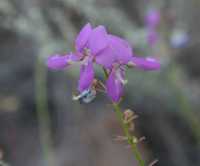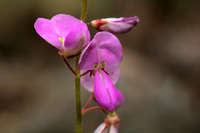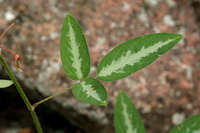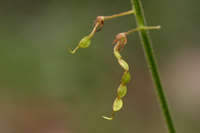Perennial, Herbs, Stems woody below, or from woody crown or caudex, Taproot present, Nodules present, Stems erect or ascending, Stems or branches arching, spreading or decumbent, Stems prostrate, trailing, or mat forming, Stems less than 1 m tall, Stems solid, Stems or young twigs sparsely to densely hairy, Stems hairs pilose or spreading, Stems with hooked uncinate hairs or prickles, Leaves alternate, Leaves petiolate, Stipules conspicuous, Stipules green, triangulate to lanceolate or foliaceous, Stipules setiform, subulate or acicular, Stipules deciduous, Stipules free, Leaves compound, Leaves pinnately 3-foliolate, Leaves odd pinnate, Leaf or leaf let margins entire, Leaflets opposite, Stipels present at base of leaflets, Leaflets 3, Leaves hairy on one or both surfaces, Inflorescences racemes, Inflorescence panicles, Inflorescence terminal, Bracts very small, absent or caducous, Bracts hairy, Bracteoles present, Flowers zygomorphic, Calyx 2-lipped or 2-lobed, Calyx hairy, Petals separate, Corolla papilionaceous, Petals clawed, Petals blue, lavander to purple, or violet, Banner petal ovoid or obovate, Wing petals narrow, oblanceolate to oblong, Wing tips obtuse or rounded, Keel tips obtuse or rounded, not beaked, Stamens 9-10, Stamens diadelphous, 9 united, 1 free, Filaments glabrous, Style terete, Fruit a loment, jointed, separating into articles, Fruit unilocular, Fruit indehiscent, Fruit elongate, straight, Fruit exserted from calyx, Fruit compressed between seeds, Fruit hairy, Fruit 2-seeded, Fruit 3-10 seeded, Seeds ovoid to rounded in outline, Seeds reniform, Seed surface smooth, Seeds olive, brown, or black, < br> Desmodium batocaulon Perennial, Herbs, Stems woody below, or from woody crown or caudex, Taproot present, Nodules present, Stems or branches arching, spreading or decumbent, Stems less than 1 m tall, Stems solid, Stems or young twigs sparsely to densely hairy, Stems with hooked uncinate hairs or prickles, Leaves alternate, Leaves petiolate, Stipules conspicuous, Stipules green, triangulate to lanceolate or foliaceous, Stipules persistent, Stipules free, Leaves compound, Leaves pinnately 3-foliolate, Leaves odd pinnate, Leaf or leaflet margins entire, Leaflets opposite, Stipels present at base of leaflets, Leaflets 3, Leaves hairy on one or both surfaces, Inflorescences racemes, Inflorescence axillary, Inflorescence terminal, Bracts very small, absent or caducous, Bracts hairy, Bracteoles present, Flowers zygomorphic, Calyx 2-lipped or 2
Duration: Perennial
Nativity: Native
Lifeform: Forb/Herb
General: Stems diffuse to decumbent, 30 cm or more tall.
Leaves: Trifoliate leaves, leaflets oblong or oblanceolate, dark green above, lighter in color beneath, without conspicuously reticulate veins, leaflets oblong lanceolate to elliptic oblong, strigose, mostly more than 1 cm wide, the terminal one rarely less than 3 times as long as wide.
Flowers: In terminal or axillary racemes, simple or compound, corolla purple, pink, or white, with a protruding style, bracts ovate, closely overlapping, to 6 mm long, pubescent.
Fruits: Flat pubescent or glabrous loments with several single seeded segments, segments of fruit not more than 4 mm long, indehiscent, but less deeply notched above than below.
Ecology: Found in pine woods from 3,500-6,500 ft (1067-1981 m); flowering June-September.
Notes: The keys to this species are the closely overlapping floral bracts, the closely packed single seeds of the loments, and the leaves which are not noticeably reticulate veined, something that is common among many of the Desmodium.
Ethnobotany: There is no specific use recorded for this species, however the genus was used as an infusion to treat vomiting and colds and as a wash for sores.
Etymology: Desmodium is from the Greek desmos for chain, which is a reference to the jointed seed pods, while batocaulon is of uncertain origin.
Synonyms: Meibomia batocaulis
Editor: LCrumbacher, 2011







